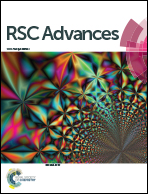Probing the compatibility of energetic binder poly-glycidyl nitrate with energetic plasticizers: thermal, rheological and DFT studies†
Abstract
The essential idea of developing energetic binders and plasticizers is to enhance the thermal stability and energy content, improve the oxygen balance and burning behaviour of moulds, reduce the glass transition temperature and improve other mechanical properties of propellant and explosives formulations. The compatibility of energetic binder poly-glycidyl nitrate (PGN) with some energetic plasticizers of solid propellants was studied using differential scanning calorimetry (DSC), rheology and DFT methods in relation to the effect of the addition of five different energetic plasticizers, i.e. bis(2,2-dinitro propyl) acetal (BDNPA), dinitro-diaza-alkanes (DNDA-57), 1,2,4-butanetriol trinitrate (BTTN), N-N-butyl-N′(2-nitroxy-ethyl) nitramine (BuNENA) and diethyleneglycol dinitrate (DEGDN), on the rheological and thermal properties of the energetic binder PGN. The results obtained for the mixture of plasticizer and binder with respect to decomposition temperature (Tmax) and the format of the peak are compared with the results obtained for the pure binder, indicating the compatibility of these plasticizers with PGN. The glass transition temperatures (Tg) of all these mixes were determined by low-temperature DSC, which showed a lowering of Tg with a single peak. Rheological evaluation revealed that the viscosity of the binder is sufficiently lowered with an increase in flow behaviour on addition of 20% (w/w) plasticizer. The addition of 20% DEGDN has the maximum effect on the lowering of the viscosity of PGN. Quantum chemically derived molecular electrostatic potential (MESP) shows the possible sites of interaction of plasticizers and binder with the estimated lowest Vmin values and their magnitudes provide an insight into their mutual interactions. The relative trend in interaction energies between plasticizer and binder, PGN, is well correlated with a corresponding trend in the ability of plasticizers towards reducing the viscosity of PGN. The information gathered in the present study would in general be valuable with respect to designing new plasticizers.


 Please wait while we load your content...
Please wait while we load your content...